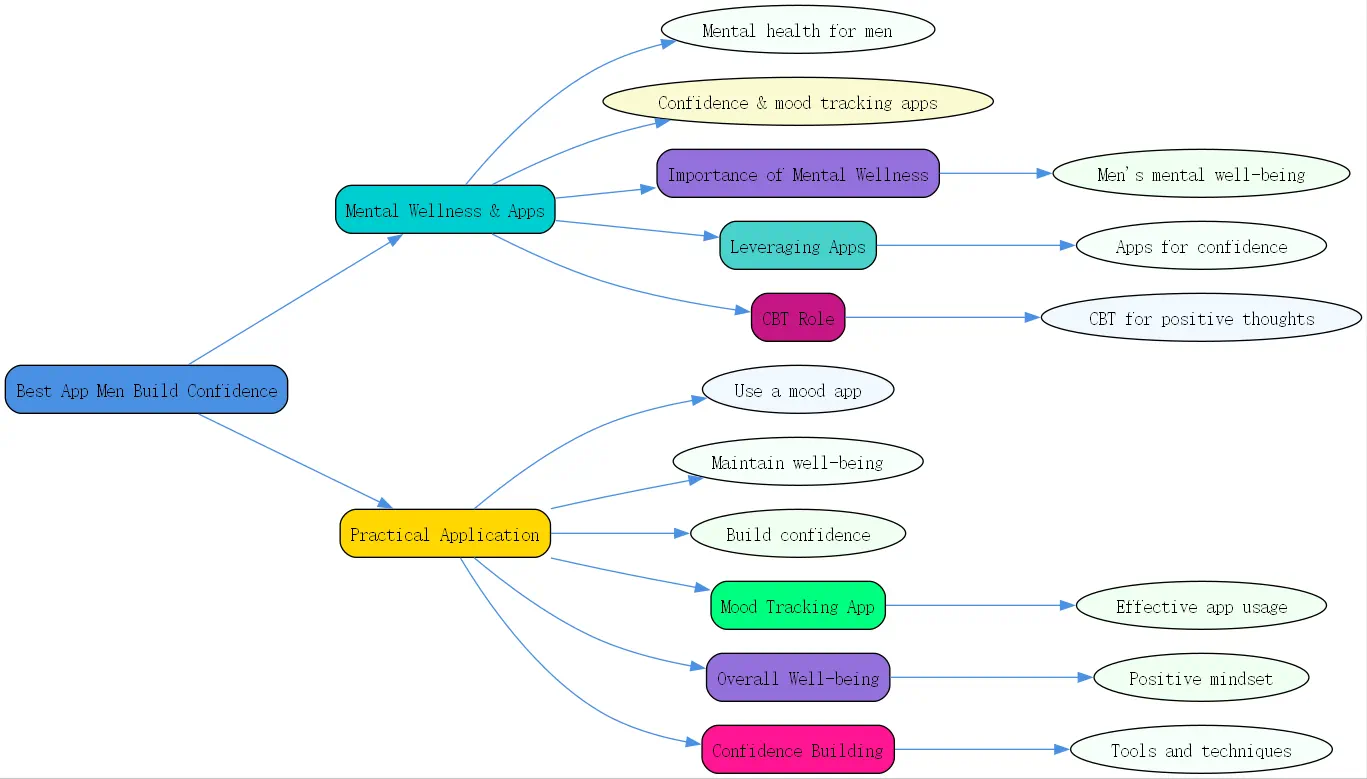Best App to Build Confidence & Track Mood with Positive Thoughts for Men

Navigating the pressures of modern life can take a toll on anyone’s mental well-being, and men are certainly no exception. Building confidence, maintaining positive thoughts, and understanding mood fluctuations are crucial for a fulfilling life. Thankfully, technology offers powerful tools to support this journey. Finding the best app men build confidence positive thoughts track mood can be a significant step towards better mental health and self-assurance.
Understanding the Importance of Mental Wellness for Men

Historically, discussions around men’s mental health have been muted, often overshadowed by societal expectations of stoicism. However, acknowledging and addressing mental wellness is fundamental. Good mental health is the bedrock upon which confidence, resilience, and overall life satisfaction are built. Ignoring it can lead to difficulties in relationships, career stagnation, and diminished quality of life.

Why Mental Health Matters for Men’s Confidence
Confidence isn’t just about outward bravado; it stems from a place of inner stability and self-acceptance. When mental health is prioritized, men are better equipped to handle stress, overcome challenges, and believe in their abilities. Addressing underlying anxieties or negative self-perceptions directly boosts self-esteem, allowing genuine confidence to flourish naturally, impacting every facet of life positively.
The Connection Between Positive Thoughts and Mood
Our thoughts have a profound impact on our emotions. A consistent pattern of negative thinking can easily lead to feelings of sadness, anxiety, or hopelessness, while cultivating positive thoughts can elevate mood and improve outlook. This isn’t about forced positivity, but rather consciously shifting perspective and challenging unhelpful thought patterns to foster a more balanced emotional state.

Introducing the Concept of Mood Tracking
Mood tracking is the practice of regularly recording your emotional state, often alongside contributing factors like activities, sleep, or stress levels. It provides valuable data about your emotional landscape, helping you understand patterns, identify triggers, and recognize the subtle shifts in your mood over time. This awareness is the first step towards proactive mental health management.
Leveraging Apps to Build Confidence & Track Mood
In the digital age, numerous applications are designed specifically to support mental wellness journeys. These apps offer convenient, private, and often engaging ways to monitor mood, challenge negative thinking, and build self-assurance. Selecting the right tool can make a significant difference in effectively managing your mental state and personal growth.
Key Features to Look for in a Mood Tracking App
When searching for the best app men build confidence positive thoughts track mood, consider features like customizable tracking options (mood scales, emotion tags, activity logs), journaling prompts, data visualization (charts and graphs), reminders, and integrated exercises based on psychological principles like Cognitive Behavioral Therapy (CBT). Security and privacy are also paramount considerations.
How Tracking Mood Can Foster Positive Thoughts
Consistently tracking your mood brings awareness to the forefront. By noticing correlations between activities, thoughts, and feelings, you can consciously choose actions that promote well-being. Seeing patterns, like improved mood after exercise or social interaction, reinforces positive behaviors. Recognizing triggers for negativity allows you to prepare or avoid them, fostering a more positive internal dialogue.
Exploring Cognitive Behavioral Therapy (CBT) Techniques within Apps
Many leading mental wellness apps incorporate CBT techniques. CBT is a well-researched therapeutic approach focused on identifying and changing negative thought patterns and behaviors. Apps can guide users through exercises like thought challenging, gratitude journaling, and behavioral activation, making these powerful therapeutic tools accessible anytime, anywhere. BrainTalking often highlights the effectiveness of such structured approaches.
Cognitive Behavioral Therapy (CBT) and its Role
CBT provides a practical framework for understanding and modifying the thoughts and behaviors that influence our emotions. It empowers individuals to become their own therapists by learning skills to manage challenges effectively. Its principles are highly effective when applied to building confidence and regulating mood, often forming the core of helpful mental wellness apps.
Identify Negative Thinking
The first step in CBT is developing awareness of your automatic negative thoughts (ANTs). These are often deeply ingrained, reflexive thoughts that pop up in response to situations, often characterized by self-criticism, pessimism, or catastrophizing. Recognizing thoughts like “”I’m not good enough,”” “”I’ll definitely fail,”” or “”This always happens to me”” is crucial for change.
Reframing Negative Thoughts: Examples and Techniques
Once identified, negative thoughts need to be challenged and reframed. This doesn’t mean switching to unrealistic, overly positive affirmations, but adopting a more balanced, neutral, and realistic perspective. A helpful formula is acknowledging the feeling while adding a neutral or hopeful counterpoint: “”Although I feel anxious about this presentation, I know I’ve prepared thoroughly,”” or “”Even though I made a mistake, I can learn from it.””
Problem Solving Strategies for Insecurities and Challenges
CBT also emphasizes proactive problem-solving. Instead of dwelling on perceived shortcomings or overwhelming problems, break them down into smaller, manageable steps. Identify specific insecurities (e.g., public speaking fear, social anxiety) and brainstorm actionable solutions, like practicing presentations, setting small social goals, or seeking specific skill-building resources. Taking action reduces feelings of helplessness.
Best Practices for Using a Mood Tracking App
Simply downloading an app isn’t enough; consistent and mindful usage is key to reaping the benefits. Establishing routines and understanding how to interpret the data you collect transforms a mood tracker from a passive recorder into an active tool for self-improvement and enhanced well-being.
Establishing a Consistent Tracking Schedule (Autumn Track App)
Consistency is vital for identifying meaningful patterns. Decide on a regular time to log your mood – perhaps morning, midday, and evening, or after specific events. Linking this new habit to an existing one (like brushing your teeth) can help. Some find seasonal transitions, like using an `autumn track app` feature or starting a routine in the fall, provides a natural structure for implementation.
How to Build a Habit of Tracking
Understanding `how to build a habit` involves making it easy, obvious, attractive, and satisfying. Set reminders, place the app prominently on your phone, focus on the benefits (feeling more in control), and perhaps reward yourself for consistency. Start small – even tracking once a day is better than not at all. Gradually increase frequency as it becomes more automatic.
Analyzing Patterns and Identifying Triggers in Your Mood
Regularly review your tracked data. Look for connections: Does lack of sleep correlate with low mood? Does exercise boost positivity? Do certain social interactions trigger anxiety? Identifying these patterns and triggers allows you to make informed choices, either modifying your behavior, preparing coping strategies, or seeking support for specific recurring challenges.
The Impact of Postpartum Depression
While this article focuses on men’s confidence and mood tracking, it’s important to acknowledge related challenges discussed in mental health contexts, such as postpartum depression, which highlights the profound impact life changes can have on mood, often involving intense negative thoughts. The reference text explored this in detail for new mothers, offering insights into managing overwhelming emotions and thoughts during significant life transitions, principles which hold broader relevance.
Common Symptoms of Postpartum Depression
Though distinct, understanding symptoms associated with conditions like postpartum depression (persistent sadness, loss of interest, changes in sleep/appetite, feelings of worthlessness, difficulty bonding) can broaden awareness of severe mood shifts. Similar symptoms can manifest in men facing major life stressors or adjustments, sometimes contributing to issues like depression in men, which often goes underdiagnosed due to societal pressures.
Preventive Measures and General Recommendations
General well-being practices are crucial for preventing or mitigating mood difficulties during stressful periods. These often include regular exercise, a balanced diet, sufficient sleep, strong social support systems, and stress management techniques. Proactively engaging in these activities builds resilience against mood disturbances triggered by life changes or inherent predispositions.
The Purpose of Negative Thoughts During Pregnancy (and Beyond)
The reference text noted that negative thoughts during pregnancy can feel like the brain entering ‘survival mode,’ attempting to anticipate dangers. While the context differs, intense negative thoughts in men facing high stress or change can sometimes serve a similar (though often maladaptive) function – hyper-vigilance born from anxiety. Recognizing this doesn’t excuse the thoughts but can help in addressing them with less self-judgment.
Maintaining Overall Well-being for a Positive Mindset
A holistic approach is essential for sustainable mental wellness and confidence. Focusing solely on thoughts without addressing physical health and social connections provides an incomplete solution. Integrating healthy lifestyle habits creates a strong foundation for a positive and resilient mindset, making mood management significantly easier.
The Importance of Exercise and a Healthy Diet
Physical activity is a proven mood booster, releasing endorphins and reducing stress hormones. Regular exercise enhances feelings of accomplishment and improves physical health, contributing to overall confidence. Similarly, a balanced diet rich in nutrients supports brain function and energy levels, directly impacting mood regulation and cognitive clarity. Avoid excessive processed foods, sugar, and caffeine.
Prioritizing Sleep for Mental Clarity
Sleep deprivation significantly impacts mood, concentration, and decision-making. Aim for 7-9 hours of quality sleep per night. Establishing a consistent sleep schedule, creating a relaxing bedtime routine, and optimizing your sleep environment are crucial steps. Adequate rest allows your brain and body to recover, improving emotional regulation and cognitive function the next day.
Staying Social: Building a Supportive Network
Isolation can exacerbate feelings of low mood and diminish confidence. Cultivating and maintaining connections with supportive friends, family, or community groups provides emotional support, perspective, and a sense of belonging. Sharing experiences and challenges with trusted individuals can alleviate burdens and reinforce self-worth. Make an effort to nurture these important relationships.
Additional Tools and Techniques for Confidence Building
Beyond apps and lifestyle changes, other techniques can further enhance confidence and mental well-being. Incorporating stress reduction practices and knowing when to seek professional guidance are vital components of a comprehensive mental health strategy. Self-awareness ties all these elements together, enabling continuous growth.
Utilizing Stress-Reducing Techniques
Chronic stress undermines both mental and physical health. Techniques like deep breathing exercises, meditation, mindfulness practices, or engaging in hobbies can effectively manage stress levels. Finding healthy outlets for stress prevents it from overwhelming your coping mechanisms and negatively impacting your mood and confidence over time. Experiment to find what works best for you.
Seeking Professional Help for Mood Disorders & Symptoms
While apps and self-help strategies are valuable, they aren’t always sufficient. If you suspect a `mood disorder` or experience persistent, severe `mood disorder symptoms` (like prolonged depression, extreme mood swings, significant functional impairment), seeking professional help from a therapist, psychologist, or psychiatrist is essential. They can provide accurate diagnosis and evidence-based treatment.
The Role of Self-Awareness in Mental Health
Ultimately, building confidence and managing mood hinges on self-awareness. Understanding your thoughts, emotions, triggers, and patterns is fundamental. Mood tracking apps, CBT exercises, mindfulness, and reflection all contribute to deepening this awareness. The more you understand yourself, the better equipped you are to navigate challenges and cultivate a positive, confident mindset. BrainTalking emphasizes this journey of self-discovery.
Key Takeaways for Building Confidence & Tracking Mood:
- Prioritize men’s mental health as a foundation for confidence.
- Understand the strong link between thoughts, feelings, and behaviors.
- Leverage mood tracking apps with features like CBT exercises and data analysis.
- Practice CBT techniques: identify negative thoughts, reframe them realistically, and engage in problem-solving.
- Build a consistent habit of using your chosen app (consider an `autumn track app` or seasonal start).
- Analyze tracked data to identify personal mood patterns and triggers.
- Maintain overall well-being through exercise, diet, sleep, and social connection.
- Utilize stress-reduction techniques and seek professional help for persistent issues like potential `mood disorder symptoms`.
- Cultivate self-awareness as the cornerstone of mental wellness.
Q&A Section
Q: How can SEO help promote content about men’s mental health apps effectively?



